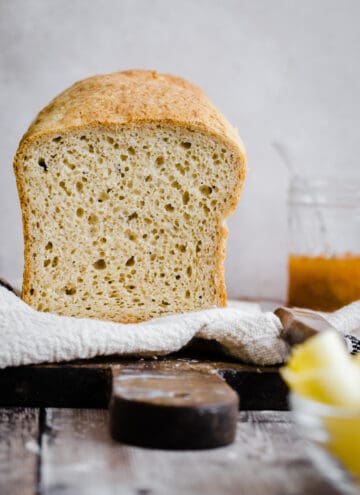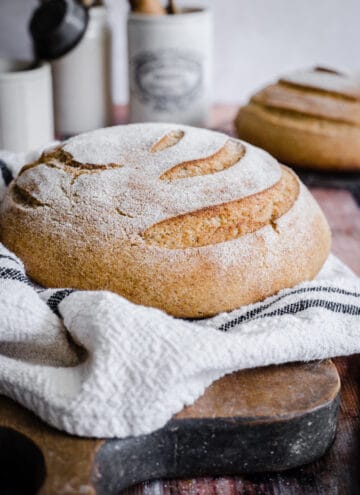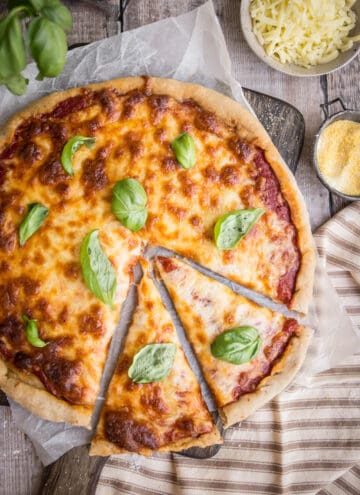This post contains affiliate links. Please read my disclosures.
This Gluten-Free Flatbread recipe is incredibly versatile and is so quick and easy to make. The bread is soft and fluffy and perfect for wraps, dipping, as a pizza base, making quesadillas. The uses are endless and we make this recipe most weeks for easy to prepare meal options. Only simple ingredients are required here – just two gluten-free flours, no psyllium husk, no xanthan gum and no yeast.
Not all gluten-free baking recipes have the same appearance of their wheat flour counterparts. For this recipe it's because we are avoiding using xanthan gum (which can be problematic for sensitive digestions) and psyllium husk since I am always asked for recipes which don't include it. Instead we use chia seeds (which is what makes the dough a little darker in colour), egg whites and carefully chosen gluten-free flours to add elasticity to this dough which allow it to be easy to roll out and give flexibility to the cooked flatbread.
Despite their rather rustic appearance these flatbreads are one of our family's most used gluten-free recipes thanks to their versatility. Plus they are easy to make ahead which means weekday lunches and dinners are a breeze.
I'll guide you through this simple recipe through the tips provided, step-by-step photos and a recipe video to ensure you make your gluten-free flatbreads perfectly first time. I guarantee it will be the first time of many.

Why You’ll Love This Gluten-Free Flatbread
- This delicious gluten free unleavened bread is so quick and easy to make. Plus you can prep the dough at the weekend to enjoy fresh flatbreads throughout the week.
- The finished flatbread is soft and fluffy and has a good amount of flex so it wraps and folds. (The flexibility actually improves if you rest the dough for a day in the fridge but this resting time is optional)
- Minimal equipment. It's a one bowl recipe (besides the bowl you'll use to make the chia seed gel) and you can just use a silicone spoon and your hands to mix it.
- So versatile. You can use these flatbreads as a component of so many meals. For me, they are one of my favourite lunches eaten like a sandwich wrap but they also make excellent naan bread or a very easy pizza crust (more suggestions below).
- And for a total bonus each flatbread has a good amount of protein and fibre so contributes to a well-balanced meal.
Watch the Video
Sometimes it helps to see a visual of what I'm talking about. So watch the video to see what it actually looks like to make your Gluten-Free Flatbreads.
Ingredients and Notes

Cassava flour. This starchy flour is great in gluten-free bread recipes because it gives that soft, chewy texture you'd expect from regular wheat bread. It really helps add stretch and elasticity to the dough. Plus, it's neutral in flavour, so it won't overpower the other ingredients, and is perfect for grain-free or nut-free diets.
Chickpea flour (gram flour, besan, garbanzo). I love using this flour in savoury breads and pastries. It is a protein packed flour which is highly versatile. It adds great structure to gluten-free bakes and has a distinctive nutty flavour and dense texture. The flavour though isn’t overpowering here and is used to give stability to our flour blend so the dough holds together. Check the labelling as well you want your flour to contain 100% chickpeas (not filled out with another legume).
Baking powder. A leaving agent which gives the flatbread a tender crumb and helps with their fluffiness. Do check your baking powder is gluten-free before use.
Bicarbonate of soda. Also known as baking soda, this is a white crystalline powder that is commonly used as a leavening agent in baking. Here it helps avoid a dense bread dough.
Salt. I like to use kosher salt in my baking as it has a round gentle flavour. Using salt in your baked goods lifts and sharpens all the other flavours.
Butter. Unsalted is the best choice here. You can substitute for melted coconut oil if you need it to be dairy-free.
Milk. Use whole milk or a plant based milk if you are making dairy-free.
Egg whites. These are used to add elasticity and helps to bind the dough, providing structure, stability, and moisture which is compensation for the lack of gluten. (The egg yolks are not needed in this recipe – I usually add them into a smoothie later to avoid wastage).
Honey. I love using honey in the flatbread. It helps add softness to the dough but also the sweetness of the honey just adds a little complexity of flavour.
Milled (ground) chia seeds. Chia seeds are great to use in the bread dough in lieu of xanthan gum as they absorb moisture and form a gel-like consistency when mixed with liquid, which means the dough has a little more elasticity and a moist and tender texture. Plus they are highly nutritious as they are high in protein and fibre. I prefer using milled chia seeds in my baking recipes as they are not as noticeable in the finished recipe and breaking them down allows them to be mixed more evenly into the dough. You can buy them ready milled.
Water. You need to mix the chia seeds with water to create the gel like consistency. Just mix the ground chia seeds with the water and leave for 5 minutes to gelatinise. If you can use tap water then this works well.
Ingredient Substitutions
I don’t recommend using a gluten-free all purpose flour or swapping the cassava flour for an alternative as the recipe won’t turn out the same.
However, you can substitute the chickpea flour for defatted almond flour (not regular almond flour) if you are sensitive chickpeas.
Dairy Free. If you need this recipe to be dairy free then there are 2 substitutions to make. Firstly swap the melted butter for coconut oil then swap the whole milk for your favourite plant based milk.

How To Make Soft and Fluffy Gluten-Free Flatbreads
For full recipe instructions go to the recipe card at the end of this post.
Prepare Chia Seed Gel: Mix ground chia seeds with water and let it sit for 5-10 minutes until gel-like.
Mix Dry Ingredients Combine gluten-free flours, baking powder, bicarbonate of soda, and salt in a large bowl.
Add Wet Ingredients: Pour the melted butter, milk, chia seed gel, egg whites, and honey into the dry ingredients.
Combine Wet and Dry Ingredients: Mix the mixture until a dough forms. Use a silicone spoon first then switching to kneading together with your hands until it forms a cohesive ball.
Shape and Cook: Divide dough into 6 equal pieces, rolling into balls. Then roll each out on a floured surface, using a rolling pin, into 7-inch rounds. Cook in a hot pan for 2-2½ minutes on each side until golden brown.
Serve: Keep flatbreads warm under a tea towel until serving.






Expert Tips
- Use precise measurements for all ingredients, this is especially the case when working with gluten-free flours. And I urge you to use digital scales, this method is much more reliable than using cup measurements - the slight variations of measuring flours that often happens when using cups must be avoided here to achieve the right texture and consistency of the flatbreads.
- To make this recipe the most efficiently I recommend melting the butter first, then making the chia seed gel as both of these ingredients need a few minutes to cool / set. Then prepare the dry ingredients in one bowl and add the
- For neat and precise honey measuring dip the teaspoon into the melted butter before using it to measure the honey.
- Ensure the melted butter has cooled before adding to the other ingredients.
- For best results tuck the just cooked flatbreads into a tea towel to keep from drying out whilst you prepare the rest of the flatbreads, or the filling for your flatbread.
- There is no resting or chilling time given in the recipe below for the dough as it doesn’t need to rest to work but I have found that if you do chill the dough overnight then it allows the ingredients to absorb the moisture thoroughly and leads to more flexible finished flatbreads.

How To Use Your Flatbread
Wraps. This is my favourite use of these flatbreads. You can fill them with anything you like, such as sliced ham, turkey or leftover roast chicken, crisp bacon, lettuce, tomato, avocado, sauerkraut, pickled onions. Don't forget the sauce. I really love smothering the inside of the flatbreads with yoghurt and chilli sauce but houmous, tzatziki, mayonnaise, pesto work really well too. Roll them up tightly and you can secure with toothpicks for a packed lunch option.
Flatbread pizza. Top them with tomato sauce, cheese, and any of your favourite pizza toppings, then bake until crispy for a quick and easy homemade pizza. (This idea is explored further below in Toppings For Your Flatbreads)
Dipping bread. Cut into strips or triangles and use to accompany houmous, tzatziki, taramasalata, sour cream dips, guacamole - anything!!
Naan or chapati substitute. Enjoy these flatbreads by mopping up the sauce in your favourite Indian curry dishes
Crispy salad strips. Cut them into strips, fry in oil and use as a crispy topping for salads or soups.
Quesadillas: Spread the flatbreads with cheese, meats, or roast vegetables, then fold in half and cook until golden and crispy for a cheesy quesadilla.
Dessert wraps. Let's not ignore the sweet option. You can spread them with Nutella, peanut butter, or cream cheese, then add sliced fruit, nuts, or chocolate chips for an easy sweet dessert option.

Flavour and Toppings For Your Flatbreads
There are even more ideas for using your flatbread by adding the flavourings or toppings to the flatbreads pre or post cooking.
Pre-cooking
- Divide and shape the dough into flatbreads as instructed in the recipe.
- Apply the flavourings or toppings to one side of each flatbread, spreading them evenly and pressing down slightly into the dough. Cook the flatbreads with the flavoured side down first which allows the flavours and toppings to meld with the dough and develop a nice crust on the bottom. Then flip over and cook the other side. The flatbreads might take a minute or two longer to cook on the flavoured side depending on the recipe.
Flavour Variations
Herb and Garlic. Mix chopped fresh herbs like parsley, basil, or coriander with minced garlic and a drizzle of olive oil. Spread this mixture over the rolled-out dough before cooking.
Sun-Dried Tomato and Pesto. Spread a thin layer of store-bought or homemade pesto over the rolled-out dough, then top with chopped sun-dried tomatoes.
Caramelised Onion and Feta. Cook thinly sliced onions in butter until caramelised, then spread them over the rolled-out dough. Sprinkle with fresh feta.
Post Cooking
This is the method you might choose if you have pre-cooked all your flatbreads for using almost like a gluten-free pizza base during the week. These are best cooked in an oven pre-heated to 200°C / 180°C fan assisted / gas mark 6 / 400°F for about 8-10 minutes.
Flavour Variations
Goats Cheese, Rocket and Prosciutto. Top cooked gluten-free flatbreads with creamy goat cheese, peppery rocket (arugula), and thinly sliced prosciutto. Bake until the cheese is melted and the prosciutto is slightly crisp,
Cheesy Garlic Flatbread. Brush cooked gluten-free flatbreads with a mixture of minced garlic and melted butter. Top with shredded mozzarella and Parmesan cheese, then bake until bubbly and golden brown (probably only 5 minutes).
BBQ Chicken Flatbread Pizza. Spread barbecue sauce over a cooked flatbread, top with shredded cooked chicken, red onions, coriander and mozzarella. Then bake until cheese is melted and bubbly.
FAQs
This recipe works very well with dairy substitutions and I recommend using melted coconut oil instead of the butter and your favourite plant based milk instead of the whole dairy milk. However, this recipe does use eggs and has not been tested with any egg substitutes to be able to confirm a vegan option.
Yes, you can make the dough up to 5 days in advance. You can choose to pre-roll the dough into balls (in which case you need to wrap each dough ball up individually in plastic wrap and then store the dough in an airtight container) or pre-rolling. Wrap in cling film and then an airtight container. The dough can be rolled out directly from the fridge.
Absolutely. Roll the dough into the individual balls then flash freeze on a baking sheet for 8 hours. Once the dough has been frozen either place in a resealable freezer bag or airtight container. Don’t forget to label including the date. To enjoy, thaw the dough balls in the refrigerator overnight, allowing them to come to room temperature before rolling out and cooking.
If you decide to cook all the flatbreads at once but want to store them for later then keep them in the fridge for up to 3 days in an airtight container. They are best eaten re-heated. Remove each flatbread from the fridge and re-heat in a dry medium sized pan for 1 ½ minutes each side, Tuck into a tea towel for 10 minutes to seal in the moisture.
You can cook the flatbreads in your favourite pan. It needs to be at least 8 inches in diameter but can be either your cast iron skillet or your favourite non-stick pan. The pan should be totally dry though - no oil is needed.
More Gluten-Free Bread Recipes You’ll Love!
✨Have you tried this Gluten-Free Flatbread recipe? If you liked it, please leave a 5-star ⭐️ ⭐️ ⭐️ ⭐️ ⭐️ rating on the recipe card and consider leaving a comment as well! I would love to hear about how your recipe turned out and your feedback also helps other readers✨

Gluten-Free Flatbread (Soft and Fluffy)
Ingredients
- 20 g ground chia seeds
- 90 g water
- 260 g cassava flour - total amount, see recipe below for how to split the amount
- 120 g chickpea flour - gram flour, besan, garbanzo
- 2 teaspoons baking powder
- ½ teaspoon bicarbonate of soda
- ¾ teaspoon sea salt
- 70 g unsalted butter - melted
- 160 g milk
- 60 g egg whites - from 2 medium sized eggs
- 2 teaspoons honey
Instructions
- Prepare the chia seed gel by combining the ground chia seeds and water in a small bowl. Let it sit for 5-10 minutes until it forms a gel-like consistency.
- In a large mixing bowl, whisk together 240g of the cassava flour, chickpea flour, salt, baking powder, and bicarbonate of soda until evenly combined.
- Create a well in the centre of the dry ingredients mixture.
- Pour the melted butter, milk, chia seed gel, egg whites, and honey into the well. Mix the ingredients together using a silicone spoon initially, then switch to using your hands, ensuring all ingredients are well incorporated.
- Once the dough has more or less come together then tip out onto a clean work surface and knead the mixture for 1-2 minutes until a smooth ball of dough forms.
- Heat a non-stick pan (or cast iron skillet) over medium heat.
- Divide the dough into 6 equal-sized balls (120-130g each).
- Lightly Flour the work surface and a rolling pin with some of the remaining cassava flour.
- Roll each dough ball into an 18cm (7 inch) round using a rolling pin, rotating and adding more flour as needed to prevent sticking. Also run your finger around the edges as you go, neatening them up as they have a tendency to go a little shaggy.
- Cook each flatbread in the pre-heated pan on a medium heat for 2-2½ minutes on each side, or until golden brown.
- As each flatbread is cooked, remove it from the pan and immediately cover loosely with a tea towel to keep it warm and prevent drying out.
Video
Notes
- Use the right flour. I don’t recommend using a gluten-free all purpose flour or swapping the cassava flour for an alternative as the recipe won’t turn out the same. However, you can substitute the chickpea flour for defatted almond flour (not regular almond flour) if you are sensitive chickpeas.
- Dairy-free version. If you need this recipe to be dairy free then there are 2 substitutions to make. Firstly swap the melted butter for coconut oil then swap the whole milk for your favourite plant based milk.
- Pre-heating the pan is essential in achieving the right cooking time for your flatbreads.
- For best results tuck the just cooked flatbreads into a tea towel to keep from drying out whilst you prepare the rest of the flatbreads, or the filling for your flatbread.
- There is no resting or chilling time given in the recipe below for the dough as it doesn’t need to rest to work but I have found that if you do chill the dough overnight then it allows the ingredients to absorb the moisture thoroughly and leads to more flexible finished flatbreads.
Make in advance
You can make the dough up to 5 days in advance. You can choose to pre-roll the dough into balls (in which case you need to wrap each dough ball up individually in plastic wrap and then store the dough in an airtight container) or pre-rolling. Wrap in cling film and then an airtight container. The dough can be rolled out directly from the fridge.Freezing the dough
Roll the dough into the individual balls then flash freeze on a baking sheet for 8 hours. Once the dough has been frozen either place in a resealable freezer bag or airtight container. Thaw the dough balls in the refrigerator overnight, allowing them to come to room temperature before rolling out and cooking.Re-heating flatbreads
Re-heat in a dry medium sized pan for 11/2 minutes each side, Tuck into a tea towel for 10 minutes to seal in the moisture.Ingredient measurements
- Please note when you see ‘grams’ listed as opposed to ‘millilitres,’ or any other term of measurement, that is not incorrect. I weigh all of my ingredients, including liquids, for accuracy.







Suzanne says
Sounds amazing? Is amazing!!! I was sceptical about using the chickpea flour as I’ve had a couple of experiences that left me disliking it. However, this recipe is so good! No strong chickpea taste and makes a terrific carrier for my sandwich. A definite keeper. Thank you so VERY much for sharing this recipe. You’re such a master of gluten-free baking that you’ve given me back a part of me that I lost when I went gluten-free.
Dare I say I forgot to grind the chia seeds. It took longer for the gel to form but I still consider it a success.
Georgina Hartley says
Hi Suzanne, I'm so happy you enjoyed the recipe!! I know - I was like you about chickpea flour but I have been using it more and more and if it's used in moderation it can really help with the structure of a recipe. Thank you so much for leaving your feedback!
Sue Gaglardi says
Sounds amazing & can’t wait to try it. Brilliant to use the chia gel! If no cast iron pan, can they be baked in a hot oven? Thank you Georgina for sharing this recipe!